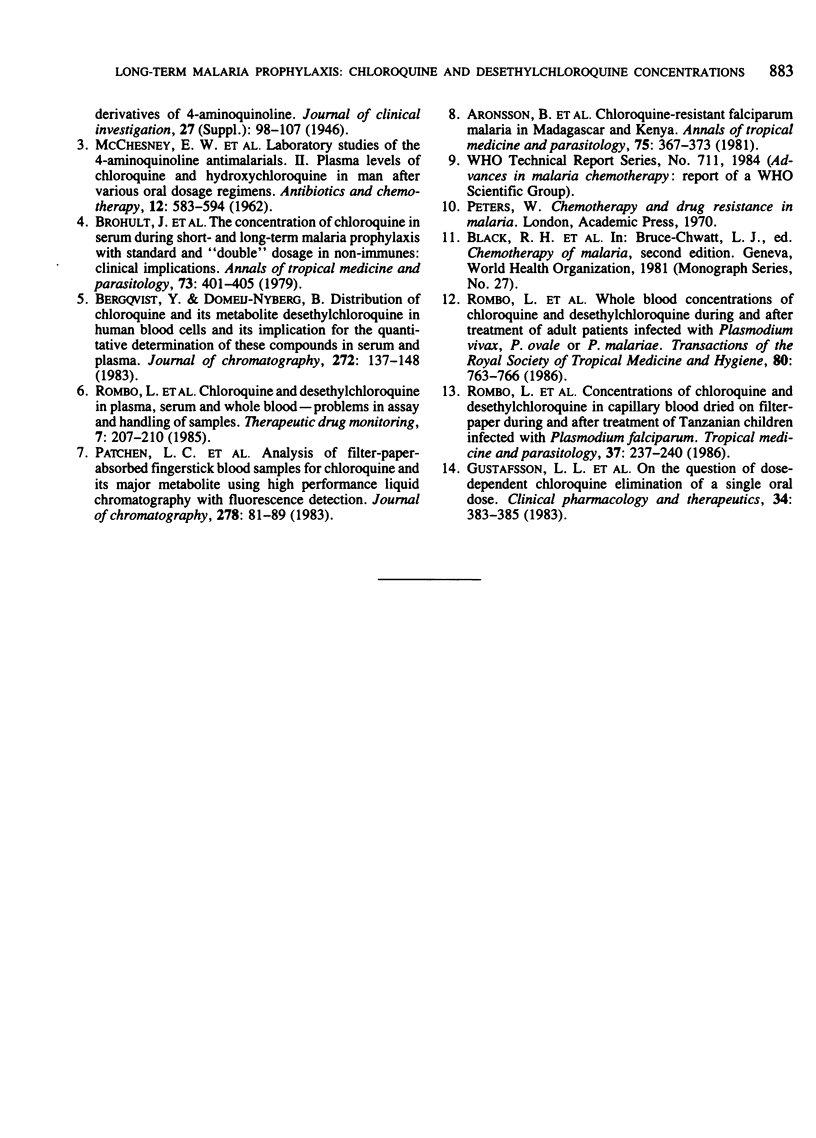Abstract
The concentrations of chloroquine and desethylchloroquine in the blood of 10 healthy adult Swedish volunteers who had been taking 310 mg chloroquine base once a week for at least 8 months for malaria prophylaxis were measured. Samples of capillary whole blood from the volunteers were dried on filter-paper and the drug and its principal metabolite determined by a specific high-performance liquid chromatography (HPLC) method. The day after taking the drug, the mean concentration of chloroquine and desethylchloroquine in whole blood were 1305 nmol/l and 915 nmol/l, respectively, and immediately before the next weekly dose, 489 nmol/l and 384 nmol/l, respectively. These are considered to be greater than the minimum inhibitory concentrations for susceptible strains but less than the maximum tolerated concentrations. The dosage of chloroquine recommended roughly 40 years ago for regular long-term prophylaxis should therefore not be changed.
Full text
PDF




Selected References
These references are in PubMed. This may not be the complete list of references from this article.
- Aronsson B., Bengtsson E., Björkman A., Pehrson P. O., Rombo L., Wahlgren M. Chloroquine-resistant falciparum malaria in Madagascar and Kenya. Ann Trop Med Parasitol. 1981 Aug;75(4):367–373. doi: 10.1080/00034983.1981.11687454. [DOI] [PubMed] [Google Scholar]
- Bergqvist Y., Domeij-Nyberg B. Distribution of chloroquine and its metabolite desethyl-chloroquine in human blood cells and its implication for the quantitative determination of these compounds in serum and plasma. J Chromatogr. 1983 Jan 14;272(1):137–148. doi: 10.1016/s0378-4347(00)86110-1. [DOI] [PubMed] [Google Scholar]
- Brohult J., Rombo L., Sirleaf V., Bengtsson E. The concentration of chloroquine in serum during short and long term malaria prophylaxis with standard and 'double' dosage in non-immunes: clinical implications. Ann Trop Med Parasitol. 1979 Oct;73(5):401–405. doi: 10.1080/00034983.1979.11687279. [DOI] [PubMed] [Google Scholar]
- Gustafsson L. L., Rombo L., Alván G., Björkman A., Lind M., Walker O. On the question of dose-dependent chloroquine elimination of a single oral dose. Clin Pharmacol Ther. 1983 Sep;34(3):383–385. doi: 10.1038/clpt.1983.183. [DOI] [PubMed] [Google Scholar]
- Patchen L. C., Mount D. L., Schwartz I. K., Churchill F. C. Analysis of filter-paper-absorbed, finger-stick blood samples for chloroquine and its major metabolite using high-performance liquid chromatography with fluorescence detection. J Chromatogr. 1983 Nov 11;278(1):81–89. doi: 10.1016/s0378-4347(00)84758-1. [DOI] [PubMed] [Google Scholar]
- Rombo L., Kihamia C. M., Mahikwano L. F., Ericsson O., Sjöqvist F. Concentrations of chloroquine and desethylchloroquine in capillary blood dried on filter paper during and after treatment of Tanzanian children infected with Plasmodium falciparum. Trop Med Parasitol. 1986 Sep;37(3):237–240. [PubMed] [Google Scholar]


